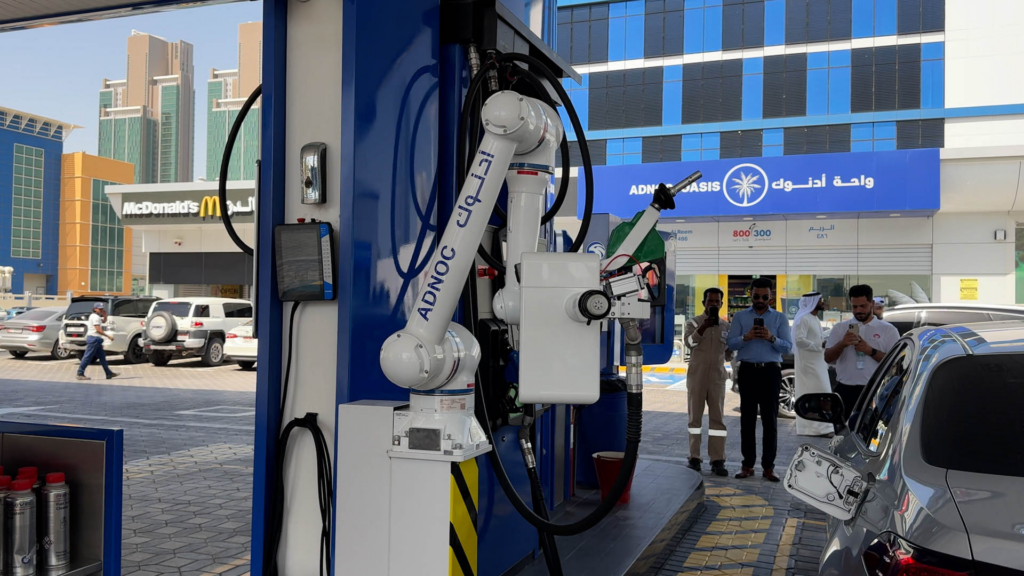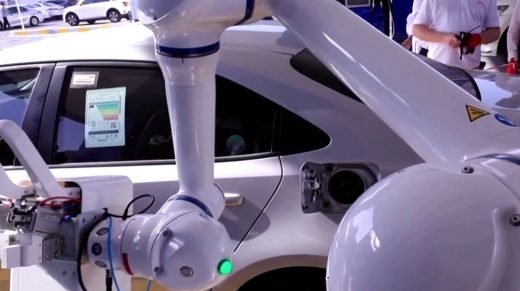Get Ready for Robot Refueling: UAE Unveils AI-powered Gas Station Arm
UAE launches AI-powered fueling robotic arm at petrol stations: The days of pumping your own gas might soon be over, at least in the United Arab Emirates. The nation’s oil giant, ADNOC (Abu Dhabi National Oil Company), is making waves with a pilot project that introduces robotic arms for refuelling vehicles. This innovative technology, powered by artificial intelligence (AI), promises to revolutionize the gas station experience, offering a touchless, efficient, and potentially eco-friendly way to fill up.

A Look Under the Hood: How the Robotic Arm Works
Imagine pulling up to a gas station and instead of grabbing the nozzle, a robotic arm extends from the pump. Sounds like science fiction? Not anymore. This robotic arm is equipped with sensors and cameras that allow it to precisely locate your car’s fuel tank. Using computer vision, it opens the cap and positions the nozzle for refuelling.
This futuristic approach boasts several advantages. Spills, a common concern with traditional methods, are minimized due to the robotic arm’s precise movements. Additionally, the system is designed for speed, aiming to significantly reduce wait times, especially during peak hours. The pilot project also explores how these robots can work alongside existing staff, potentially streamlining operations at gas stations.
Beyond Convenience: The Broader Impact of AI Refueling
The introduction of AI-powered fueling arms goes beyond just simplifying the refuelling process. It signifies a broader trend towards automation and digitalization within the oil and gas industry. Let’s delve deeper into the potential benefits:
- Enhanced Safety: Removing the human element from the refuelling process potentially reduces the risk of accidents or injuries associated with handling fuel.
- Boosting Efficiency: Automating refuelling can significantly decrease wait times, making gas station visits quicker and more convenient.
- Data-Driven Decisions: Sensors and cameras integrated with the robotic arm can collect valuable data on fuel consumption patterns and vehicle types. This data can be used to optimize inventory management and improve overall station operations.
- 24/7 Availability: Unlike human staff, robotic arms can operate continuously, paving the way for 24/7 gas stations in the future.
Challenges on the Road Ahead: Considerations for Robotic Refueling
While exciting, the technology also presents challenges that need to be addressed:
- Initial Investment: Developing and implementing robotic fueling systems requires a significant upfront cost. The pilot project will determine if the technology is cost-effective in the long run.
- Customer Comfort: Not everyone might be comfortable with a robot handling their car’s fuel tank. Building trust and ensuring a smooth user experience will be crucial for widespread adoption.
- Job Displacement: Automation in the gas station industry could lead to job losses for gas station attendants. However, new opportunities in areas like maintenance and system operation could emerge.
A Global Trend: The Future of Gas Stations
The UAE’s robotic fueling arm initiative is not an isolated event. Similar pilot projects are underway in other countries, highlighting a growing interest in automated gas stations.
This trend aligns with advancements in automation and AI across various industries. As the technology matures and user acceptance increases, we can expect to see a rise in robotic gas stations around the world.

The Future is Now: A Transformative Shift at the Pump
The introduction of AI-powered robotic fueling arms signifies a significant shift in how we interact with gas stations. While challenges remain, the potential benefits of increased efficiency, safety, and environmental responsibility are undeniable. The UAE’s pilot project paves the way for a future where robots become commonplace at the gas pump, fundamentally transforming the way we refuel our vehicles.

